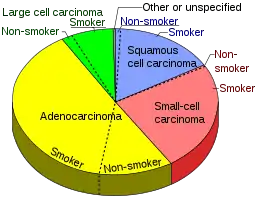Large-cell lung carcinoma
Large-cell carcinoma (LCC) is a heterogeneous group of undifferentiated malignant neoplasms that lack the cytologic and architectural features of small cell carcinoma and glandular or squamous differentiation. LCC is categorized as a type of NSCLC (non-small-cell lung carcinoma) which originates from epithelial cells of the lung.
| Large-cell carcinoma | |
|---|---|
| Specialty | Oncology/pulmonology |
Presentation
Patients typically present with a non-productive cough and weight loss.
Diagnosis
LCC is, in effect, a "diagnosis of exclusion", in that the tumor cells lack light microscopic characteristics that would classify the neoplasm as a small-cell carcinoma, squamous-cell carcinoma, adenocarcinoma, or other more specific histologic type of lung cancer.
LCC is differentiated from small-cell lung carcinoma (SCLC) primarily by the larger size of the anaplastic cells, a higher cytoplasmic-to-nuclear size ratio, and a lack of "salt-and-pepper" chromatin.
Classification
The newest revisions of the World Health Organization (WHO) "Histological Typing of Lung Cancer schema" include several variants of LCC, including:
- Giant-cell carcinoma of the lung
- Basaloid large cell carcinoma of the lung
- Clear cell carcinoma of the lung
- Lymphoepithelioma-like carcinoma of the lung
- Large-cell lung carcinoma with rhabdoid phenotype
- Large cell neuroendocrine carcinoma of the lung
Large-cell neuroendocrine carcinoma (LCNEC)
One clinically significant subtype is "large-cell neuroendocrine carcinoma" (LCNEC),[1] which is believed to derive from neuroendocrine cells.[2]
In addition, a "subvariant", called "combined large-cell neuroendocrine carcinoma" (or c-LCNEC), is recognized under the new system. To be designated a c-LCNEC, the tumor must contain at least 10% LCNEC cells, in combination with at least 10% of other forms of NSCLC.
Pathology images
Incidence

In most series, LCLC's comprise between 5% and 10% of all lung cancers.
According to the Nurses' Health Study, the risk of large cell lung carcinoma increases with a previous history of tobacco smoking, with a previous smoking duration of 30 to 40 years giving a relative risk of approximately 2.3 compared to never-smokers, and a duration of more than 40 years giving a relative risk of approximately 3.6.[4]
Another study concluded that cigarette smoking is the predominant cause of large cell lung cancer. It estimated that the odds ratio associated with smoking two or more packs/day for current smokers is 37.0 in men and 72.9 in women.[5]
American comedian Andy Kaufman was a notable sufferer of the disease, which took his life in 1984.
References
- Fernandez FG, Battafarano RJ (October 2006). "Large-cell neuroendocrine carcinoma of the lung" (PDF). Cancer Control. 13 (4): 270–5. doi:10.1177/107327480601300404. PMID 17075564.
- Cotran, Ramzi S.; Kumar, Vinay; Fausto, Nelson; Nelso Fausto; Robbins, Stanley L.; Abbas, Abul K. (2005). Robbins and Cotran pathologic basis of disease. St. Louis, Mo: Elsevier Saunders. p. 762. ISBN 978-0-7216-0187-8.
- Smokers defined as current or former smoker of more than 1 year of duration. See image page in Commons for percentages in numbers. Reference:
- Table 2 in: Kenfield SA, Wei EK, Stampfer MJ, Rosner BA, Colditz GA (2008). "Comparison of aspects of smoking among the four histological types of lung cancer". Tob Control. 17 (3): 198–204. doi:10.1136/tc.2007.022582. PMC 3044470. PMID 18390646.
- Kenfield, S. A.; Wei, E. K.; Stampfer, M. J.; Rosner, B. A.; Colditz, G. A. (2008). "Comparison of aspects of smoking among the four histological types of lung cancer". Tobacco Control. 17 (3): 198–204. doi:10.1136/tc.2007.022582. PMC 3044470. PMID 18390646.
- Muscat, JE; Stellman, SD; Zhang, ZF; Neugut, AI; Wynder, EL (July 1997). "Cigarette smoking and large cell carcinoma of the lung". Cancer Epidemiology, Biomarkers & Prevention. 6 (7): 477–80. PMID 9232332.
External links
| Classification |
|---|

